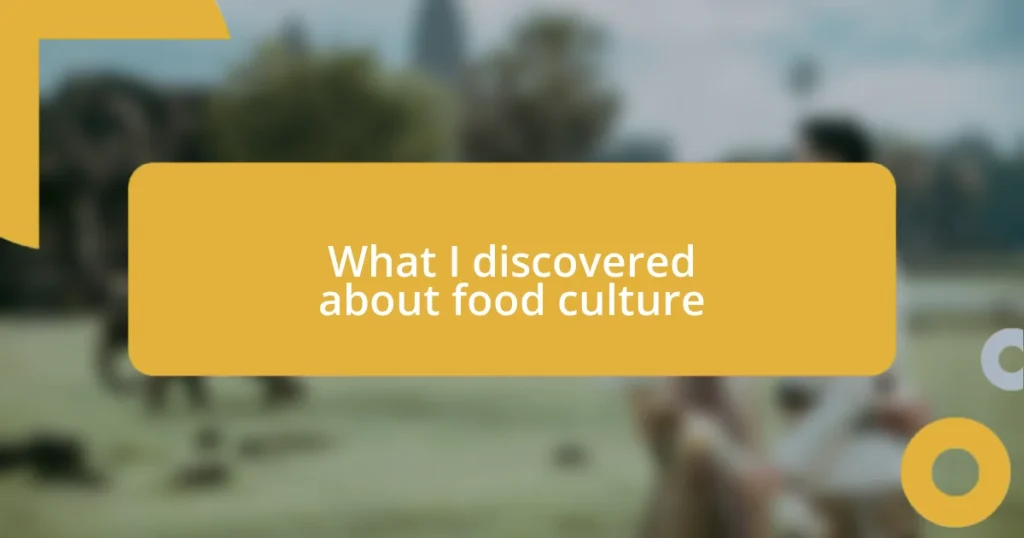Key takeaways:
- Food culture reflects history, community traditions, and personal memories, enriching our dining experiences beyond mere consumption.
- Historical influences, such as trade routes, colonialism, and migration, have shaped global cuisines, highlighting a narrative of cultural exchange and evolution.
- Trends like plant-based diets and food technology are reshaping culinary practices, prompting a balance between convenience and tradition in our food choices.

Understanding food culture
Understanding food culture goes beyond just what’s on our plates; it reflects the history, beliefs, and values of a community. I remember sitting around a dinner table in Italy, enveloped in laughter and stories, where every dish served told its own tale. It made me wonder, how often do we appreciate the deeper meanings of the meals we share?
Consider the way certain foods become symbols of celebration or comfort. In my experience, every holiday comes with its own set of dishes, each evoking memories and emotions tied to loved ones and traditions. Have you thought about how a simple bowl of soup can transport you back to your grandmother’s kitchen, where the scent alone stirred feelings of warmth and safety?
Food culture also invites us to explore the diversity of human experience. I once attended a potluck where each guest brought a dish representative of their heritage. It struck me how food can bridge cultural gaps, allowing us to connect with each other on a profound level. What if we took the time to truly understand the stories behind each bite we take?
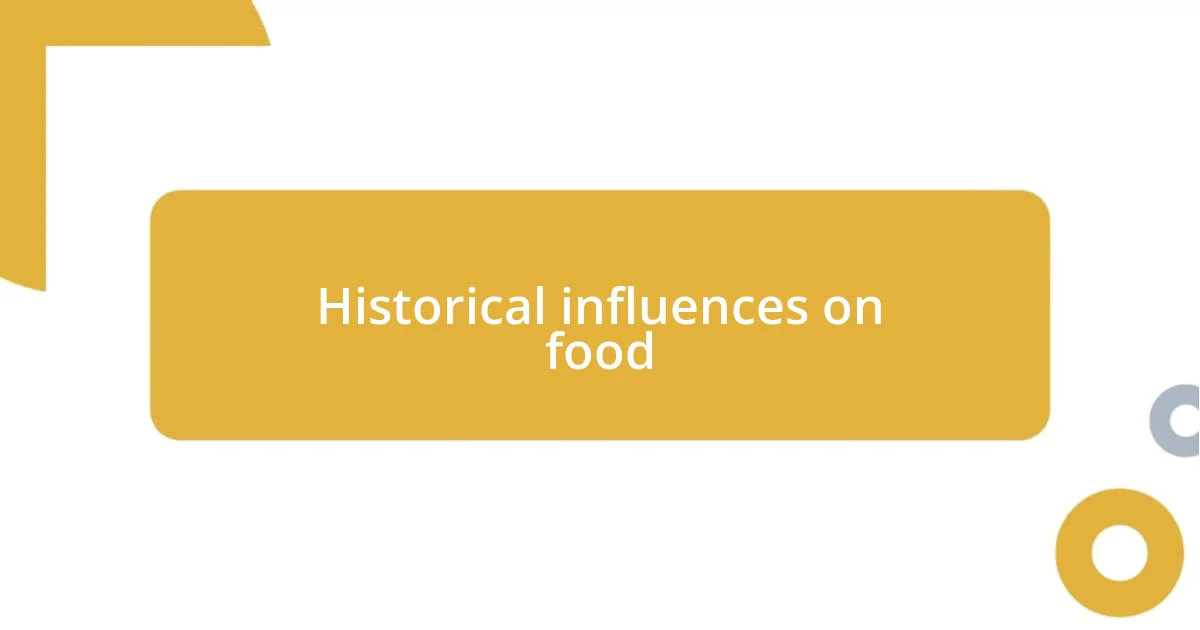
Historical influences on food
Food has always been a reflection of the history and movements of societies. I recall walking through a local market in Morocco and being captivated by the diverse spices on display. Each one had a story, reflecting not just the land it came from but also the influences of trade routes and imperial expansions over centuries. It prompted me to think about how the blending of cultures—like the spice trade shaping the flavors of cuisine—has played a pivotal role in the evolution of what we eat today.
Here are some historical influences that have transformed food cultures around the globe:
- Trade Routes: The Silk Road introduced ingredients like rice and spices to new regions, altering local cuisines.
- Colonialism: Colonizers brought their native foods, while also introducing local ingredients to their homelands, creating unique fusions.
- Migration: Waves of immigrants have enriched food landscapes, with each community adding its flavors and cooking techniques.
- Wars and Conflicts: Scarcity often leads to innovation; rationing during wartime has historically brought about new cooking methods and recipes.
- Technological Advances: The Industrial Revolution paved the way for mass production and preservation techniques, impacting diet choices globally.
These intertwined histories reveal how our food is a living narrative, telling us who we are and where we come from. Each dish we enjoy is a thread connecting us to the past, highlighting the shared experiences of humanity.
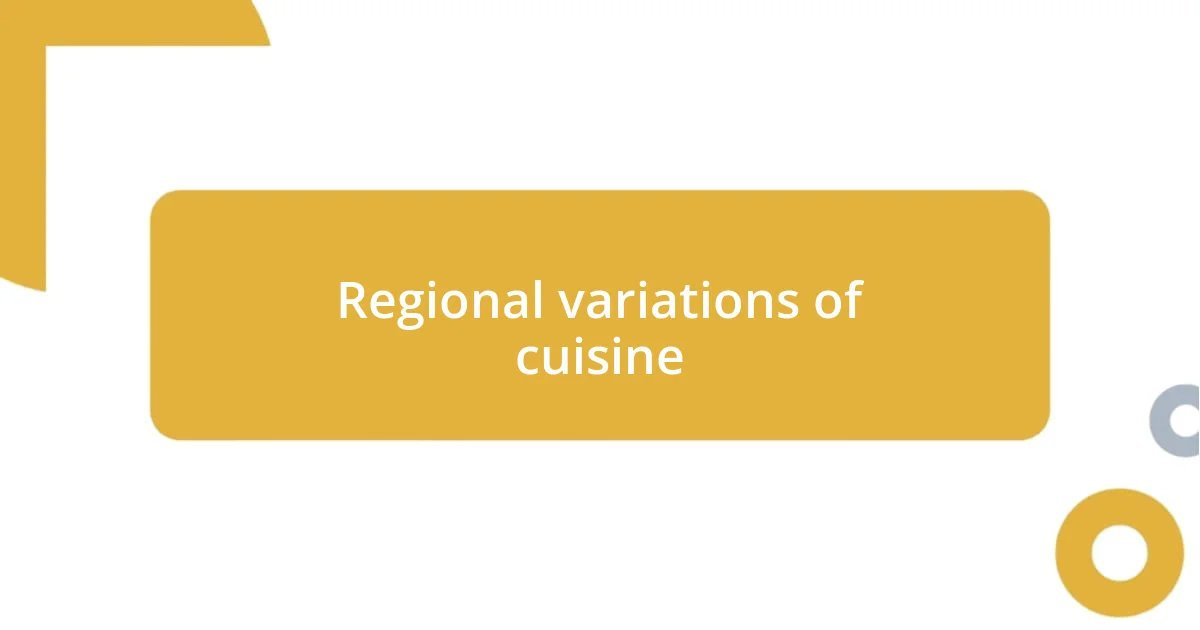
Regional variations of cuisine
The beauty of regional variations in cuisine truly showcases the world’s cultural tapestry. I’ve had the pleasure of dining in various parts of Mexico, where each region presents its own unique ingredients and cooking styles. For example, the bold and spicy dishes of the Yucatán Peninsula differ significantly from the rich and hearty flavors of Oaxaca. It’s fascinating how geography, climate, and local traditions influence what’s on the table.
In Italy, for instance, my experiences in the north versus the south were eye-opening. While the northern regions focus on creamy polentas and risottos, the south offers vibrant tomato-based sauces and seafood dishes. I remember savoring a plate of risotto in Milan that felt comforting and rich, yet when I visited Naples, the fresh pizza was bursting with bold flavors. These regional nuances not only highlight local ingredients but also tell the story of the people and their way of life.
The diversity in food preparation methods is just as striking. I remember attending a cooking class in Thailand, where I learned to prepare curry. The instructor explained how the same dish can vary drastically from one region to another, depending on the balance of flavors and the types of herbs available. This experience underscored for me that regional differences in cuisine create a wonderful kaleidoscope of tastes to explore and appreciate.
| Region | Cuisine Characteristics |
|---|---|
| Italy | Southern cuisine features tomato-based sauces, whereas northern cuisine focuses on creamy dishes. Each area offers unique ingredients based on local agriculture. |
| Mexico | The Yucatán emphasizes bold spices, while Oaxaca is known for its rich moles, showcasing how geography shapes culinary identity. |
| Thailand | Regional variations in curry reflect different herbs and flavor balances, with each area offering its own preparation methods. |
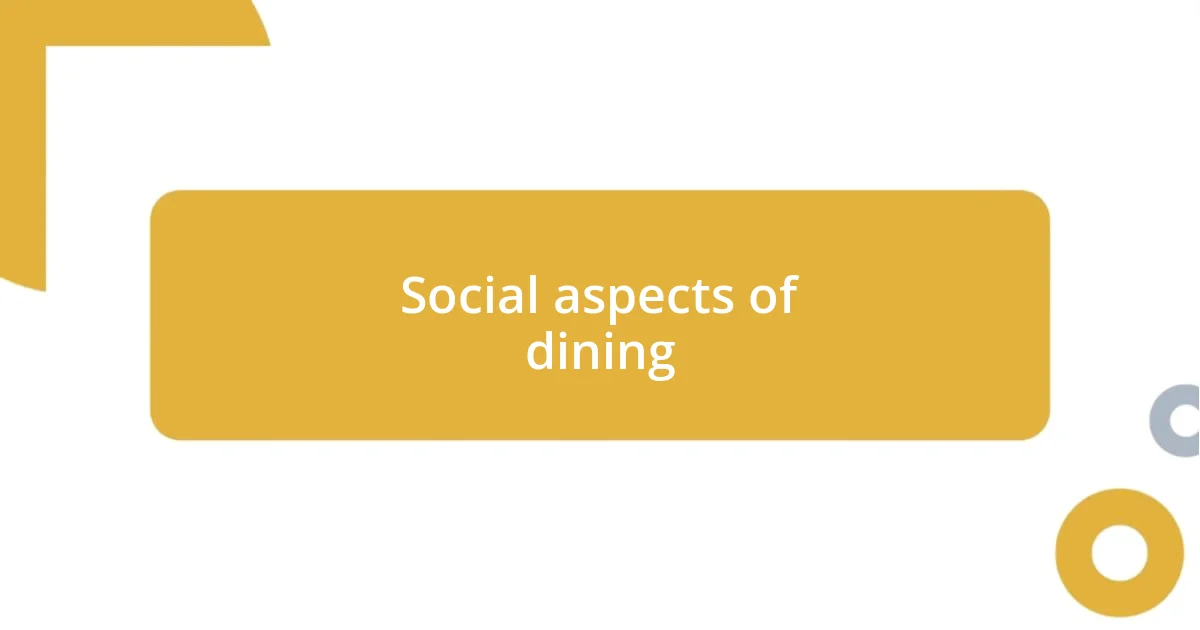
Social aspects of dining
Dining is not just about the food; it’s an experience that fosters connection and community. I vividly recall a lovely evening gathering with friends around a table, each bringing a dish from their own culture. As we shared stories about our meals, the room was filled with laughter and curiosity. It struck me how food serves as a catalyst for conversations, allowing us to explore our differences while celebrating our common humanity.
When I think about the social aspects of dining, I can’t help but reflect on the rituals that accompany meals. For instance, during my travels in Japan, I experienced traditional tea ceremonies, which seem to elevate the act of sharing food to an art form. The intentionality behind each movement and the emphasis on mindfulness during the ceremony reinforced the idea that dining is as much about the shared moment as it is about the flavors enjoyed. How often do we take the time to appreciate the process of gathering, eating, and connecting in our daily lives?
I believe that the social context in which we eat can powerfully influence our perceptions of food. For example, during a holiday celebration with family, I find that the same dish I enjoy throughout the year takes on a deeper meaning. It transforms into a symbol of nostalgia and tradition, sparking conversations about family history and lost recipes. This interplay of food and memories leaves me pondering: How does the social setting of dining shape our experiences and interpretations of what we eat?

Food and identity connection
Food is profoundly intertwined with our identities, acting as a mirror reflecting our backgrounds, values, and personal journeys. I distinctly remember visiting a local potluck where each dish told a story, revealing origins and traditions from the cooks’ lives. How incredible it is that a simple plate of food can evoke memories of childhood, heritage, or even significant life events! It’s as if every bite connects us to a larger narrative, both personal and cultural.
During my culinary adventures in Cuba, I was struck by the significance of rice and beans in their meals, not only as a staple but as a symbol of their resilience and resourcefulness. While dining with a local family, I absorbed the pride they took in preparing their meals, which had been passed down through generations. Have you ever tasted a dish and felt an immediate connection to its history? In that moment, I truly understood how food becomes a vessel for cultural identity, transcending mere nutrition to embody heritage and communal pride.
Reflecting on my own experiences, I see how my family’s recipes have shaped my identity. Each holiday, the familiar aroma of my grandmother’s tamales brings a sense of belonging and nostalgia. I wonder, what role does food play in your identity? It seems to create a sense of continuity, linking us to our roots while allowing us to share our culture with others. This profound connection highlights not just what we eat, but who we are—our tastes, our stories, and our shared humanity.
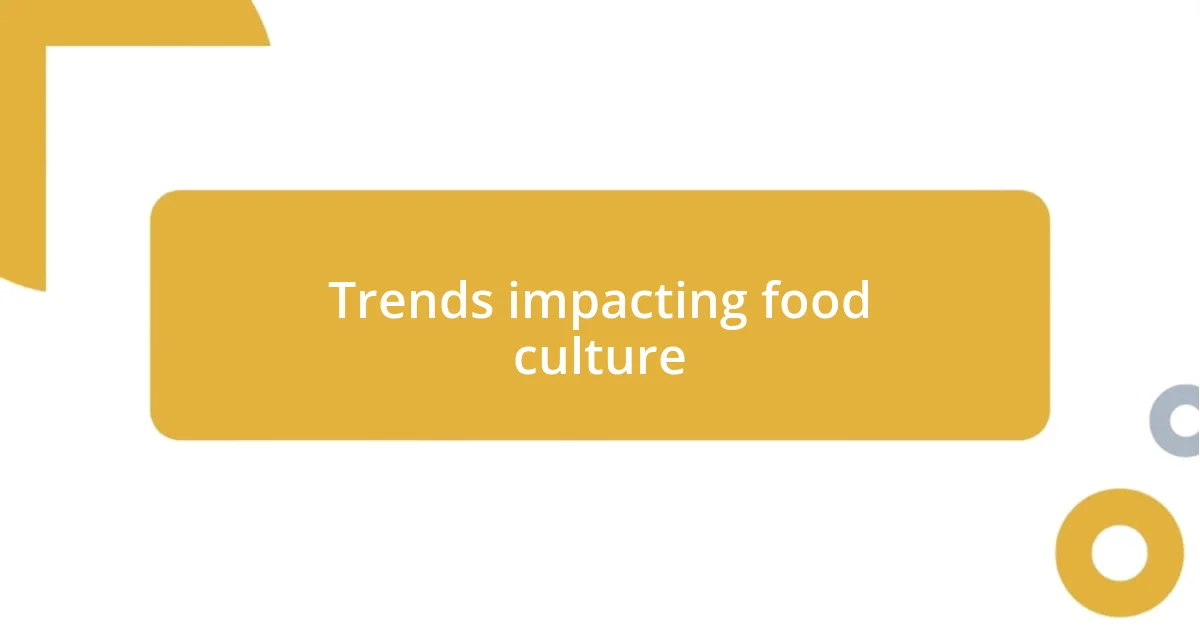
Trends impacting food culture
One of the most fascinating trends I’ve noticed in food culture is the rise of plant-based diets. I remember attending a friend’s dinner party where every dish was meticulously prepared with fresh vegetables, legumes, and grains. As I savored each bite, I couldn’t help but appreciate how this shift towards plant-based eating not only promotes health but also emphasizes sustainability. Isn’t it remarkable how our food choices can impact the environment while simultaneously celebrating diverse flavors?
Another trend that caught my attention is the growing influence of global cuisine on local dining scenes. I still fondly recall a food festival I visited that showcased everything from Ethiopian injera to Vietnamese pho. Each stall was a tiny world of its own, where chefs merged traditional recipes with local ingredients. This blending of cultures is like food diplomacy—it breaks down barriers and fosters a greater understanding of our shared experiences. Have you ever tasted something that transported you to another country? Those meals resonate with a story, expanding our culinary horizons.
Lastly, the emergence of food technology, such as meal kits and food delivery apps, has transformed how we perceive cooking. I remember feeling intrigued when I tried a meal kit for the first time—it felt like recreating a restaurant experience at home. This convenience allows us to experiment with new cuisines that we may not have tried otherwise. But isn’t there something to be said about losing the personal touch of home-cooked meals? These trends make me reflect: how do convenience and tradition coexist in your culinary journey? It’s an ongoing balance, and I believe each choice we make contributes to the evolving story of food culture.
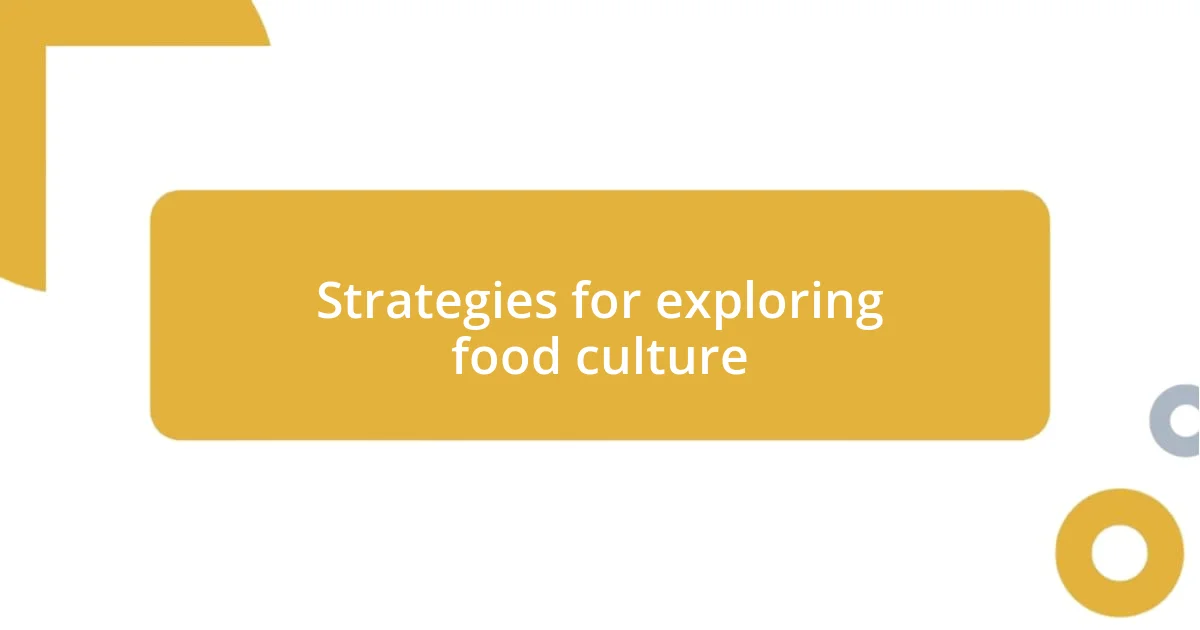
Strategies for exploring food culture
Exploring food culture can be an enriching adventure, and one effective strategy I’ve found is to immerse myself in local markets. I still remember the bustling energy of a night market I visited in Thailand, where the vibrant colors and aromas pulled me in. Engaging with vendors and sampling street food revealed not only delicious flavors but also stories behind each dish. Have you ever felt the thrill of discovering something completely new while wandering through a market?
Another approach is to participate in community cooking classes, which allow for hands-on experiences with different cuisines. I once attended a Mexican cooking class where we learned to make mole from scratch. The process felt sacred, and as we concocted this rich sauce, the instructor shared tales of family traditions tied to the recipe. Has a cooking class ever deepened your appreciation for a culture? The laughter and shared effort in the kitchen made the experience unforgettable, highlighting how food can bring people together.
Finally, I recommend documenting your culinary experiences through a food journal. This strategy may seem simple, but it can profoundly shift your perspective. I often jot down my thoughts and feelings about the dishes I try, allowing me to reflect on their cultural significance. Have you ever paused to think about how a meal made you feel? This practice not only enhances my appreciation for diverse cuisines but also creates a personal narrative that intertwines with my food journey. Each entry becomes a chapter in my exploration of food culture, connecting me to memories I cherish.










